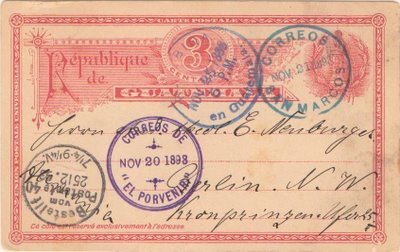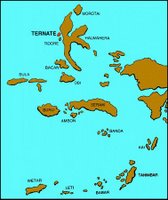
Shown above is a common 3-centavo Guatemalan postal card [PC 6] issued in 1890 in a quantity of 200,000 and used into the 20th century. The four bold, different-colored cancels, nicely struck on the card's face, imbue this card with philatelic character and enable the postal historian to trace its journey from an obscure Guatemalan hamlet to Berlin, Germany, in 1893, thus:
- "El Porvenir", November 20, 1893 [violet]
- San Marcos, November 21, 1893 [green transit]
- Guatemala City, November 25, 1893 [blue transit]
- Berlin, Germany, December 25, 1893 [black receiver]
Quite a contrast to Luxembourg's single and double circle cancels of the same era, which we might characterize as a bit boring!
 The other new arrival is a postal card from Curaçao--an interesting use of the 7½-cent William III card [G8], which was issued in a quantity of only 20,609 on April 1, 1886, and was demonetized on April 15, 1893. As with the Guatemalan card, we see four cancels on the face of the card. The blue cancellation is that of Curaçao, June 14, 1886. The card is addressed to a midshipman (adelborst 1e klasse in Dutch) in Batavia "of elders" (= or elsewhere), Dutch East Indies. It shows a Weltevreden [near Batavia] receiver, August 1, 1886, (not quite as fast as e-mail!); however, the midshipman was at that time in Ternate (in the Moluccas), so we see a handwritten note in pencil "Tromp" (the name of the ship) and "Ternate" (the new destination). There is a Soerabaja transit cancel, August 4, 1886, and finally the Ternate arrival cancel, August 23, 1886, documenting a journey of 70 days--a lot of postal history on the face of a scarce Curaçao
The other new arrival is a postal card from Curaçao--an interesting use of the 7½-cent William III card [G8], which was issued in a quantity of only 20,609 on April 1, 1886, and was demonetized on April 15, 1893. As with the Guatemalan card, we see four cancels on the face of the card. The blue cancellation is that of Curaçao, June 14, 1886. The card is addressed to a midshipman (adelborst 1e klasse in Dutch) in Batavia "of elders" (= or elsewhere), Dutch East Indies. It shows a Weltevreden [near Batavia] receiver, August 1, 1886, (not quite as fast as e-mail!); however, the midshipman was at that time in Ternate (in the Moluccas), so we see a handwritten note in pencil "Tromp" (the name of the ship) and "Ternate" (the new destination). There is a Soerabaja transit cancel, August 4, 1886, and finally the Ternate arrival cancel, August 23, 1886, documenting a journey of 70 days--a lot of postal history on the face of a scarce Curaçao postal card!
postal card!
And the backside reminds us of the frugality of that era--crosswriting!

No comments:
Post a Comment